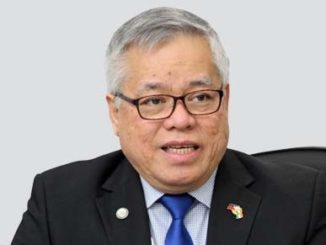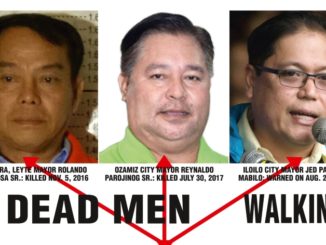
At the MOPC Finance Forum last Thursday (Sept. 21), Finance Secretary Sonny Dominguez defined the three major goals of the Rodrigo Roa Duterte government – reduce poverty, reduce corruption, and reduce illegal drugs.
“At the end of the term (of Duterte) we want to achieve just three goals,” said Dominguez: Reduce the poverty rate of 22 percent to around 14 percent; make this country more compliant with the law…by going after the (biggest) violations which are drugs, tax evasion, and terrorism; and achieve peace. Sonny equates peace with rebellion and separatism. I equate peace with social stability; hence, poverty reduction.
Poverty is to be reduced from 21.6 percent at present to 14 percent by 2022, the equivalent of rescuing six million people from poverty – defined as not earning at least $1 a day or P18,600 a year. No president has rescued six million Filipinos from the clutches of misery before. Under BS Aquino, the number of Filipinos who were poor swelled by two million.
Corruption is supposed to be reduced to zero. No president has done it before.
Illegal drugs is a recent phenomenon. The menace prospered under BS Aquino III.
While campaigning for president, Duterte promised to drown 100,000 drug addicts at Manila Bay, out of more than three million addicts. So far, the police admit to killing 3,800, out of some 14,000 alleged to have been killed under all kinds of circumstances (meaning including those murdered by angry spouses). With Duterte spending enormous capital to pursue illegal drugs, he is a success story. So successful has he been that the western media regularly portray him as a butcher and a gross human rights violator.
The real shock and awe is the administration’s goal of economic inclusion. This 2017, there are 105 million Filipinos. So 21.6 percent of that is 22.68 million, the number of poor Filipinos. By 2022, there would be about 114 million; 14 percent of that is 15.96 million. So 22.68 million minus 15.96 million is 6.72 million—the number of Filipinos to be rescued from poverty.
To save those 6.7 million Filipinos, the administration needs cash. That cash will come from taxes. From income of wage earners, professionals and businessmen. From purchases of assets like cars and other luxuries. From consumption of drinks and items like bread, cake and candy laced with sugar. There is even a plan to tax cosmetics and body improvements like facial lift, breast lift, lipo and all kinds of mangling of the body disguised as plastic surgery.
People earning not more than P250,000 a year will not pay any income tax, if they have four children. Today, those people pay an average of 20 percent because of the withholding tax system. Professionals and businessmen income tax as little as 1.8 percent or none at all. They and their companies enjoy all kinds of tax exemptions and perks. Businessmen, defined as self-employed, will pay an average of 8 percent on income, beginning 2018. In general, Duterte’s tax bill, assures the DOF, will reduce the income tax of 99 percent of 7.5 million taxpayers. Only about two million of the 7.5 million taxpayers pay income taxes anyway.
Cars retailing for P2 million or below will be slapped excise taxes averaging 20 percent. Cars priced above P2 million will taxed 33 percent of retail price on the average.
The Senate Ways and Means Committee has adopted the House’s five-tier auto sales excise tax rates and exempts from excise tax hybrid and electric cars but they should be able to run without gasoline or diesel for 30 kms. Coal will have higher excise tax.
Sugar-sweetened beverages (SSB) will still be taxed P5 per liter for beverages with caloric sweeteners, P3 for those with non-caloric sweeteners, and P10 for those that use high fructose corn syrup (HFCS).
After two years, the SSB tax will be P0.05 per gram of sugar per beverage — which is a tax regime that hopefully incentivizes manufacturers to produce and consumers to drink less sugary drinks.
Exempt from tax is “3-in-1” coffee as well as milk (plain milk, infant formula milk, and growing up milk; and powdered, ready to drink, flavored and fermented milk with less than 5 grams of sugar per 100ml) given their nutritional value. About 90 percent of consumers of 3-in-1 coffee are low-income earners. Also excluded are beverages with 100 percent natural fruit and vegetable juices, unsweetened tea, meal replacement and medically indicated beverages. Sweetened beverages that used coco sugar and stevia are also excluded.
The sugar tax is supposed to curb obesity and diabetes. DOF estimates the nation spends P300 billion a year on treatment of diabetes. PhilHealth, if you believe Dominguez, will soon go bankrupt. So the P47 billion expected revenues from sugar tax seem like a bargain
The tax on diesel is calibrated at P1.75 a liter in the first year; P2 in the second; and P2.25 per liter in the third, to minimize the shock to the economy and to keep inflation within target so as to prevent undue increase in prices of commodities.
The original proposal of DOF was a P6 increase per liter, while House Bill 5636 had a phased implementation of 3-2-1.
According to DOF, the richest 2 million families (or richest 10% of Filipinos) consume 50 percent of oil products.
Estates and donations will be subject to a flat 6 percent tax on the net estate. Estates worth P200,000 or less have no tax. Those above P10 million will pay P1.25 million estate tax plus 20 percent of amounts above P10 million.
Sonny Angara said the tax bill will raise P134 billion in additional revenues. Much of that money will given to the poor – either as cash doleouts, subsidies, and projects like free tuition in college.
The Senate tax version adopts the House’s P3-million threshold for VAT- exempt sale or lease of goods and services — from P1.9 million. Small businesses with P3 million or below annual sales are also exempt from paying VAT, and also from filing the monthly VAT return and quarterly percentage tax returns.
Retained for VAT exemptions are sales related to food production, health care, and socialized housing, the BPO industry, cooperatives, PWDs (persons with disabilities), and senior citizens.



